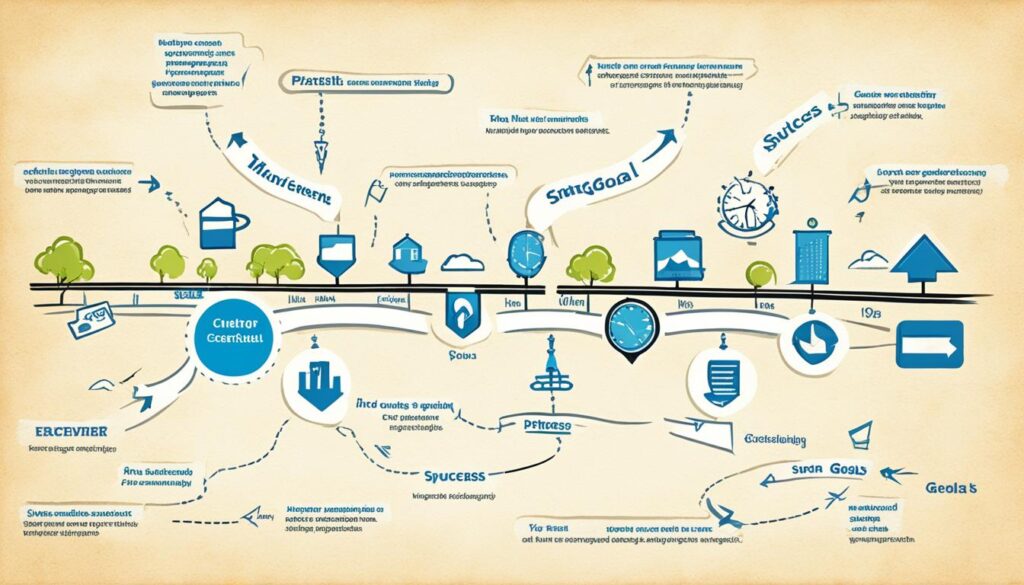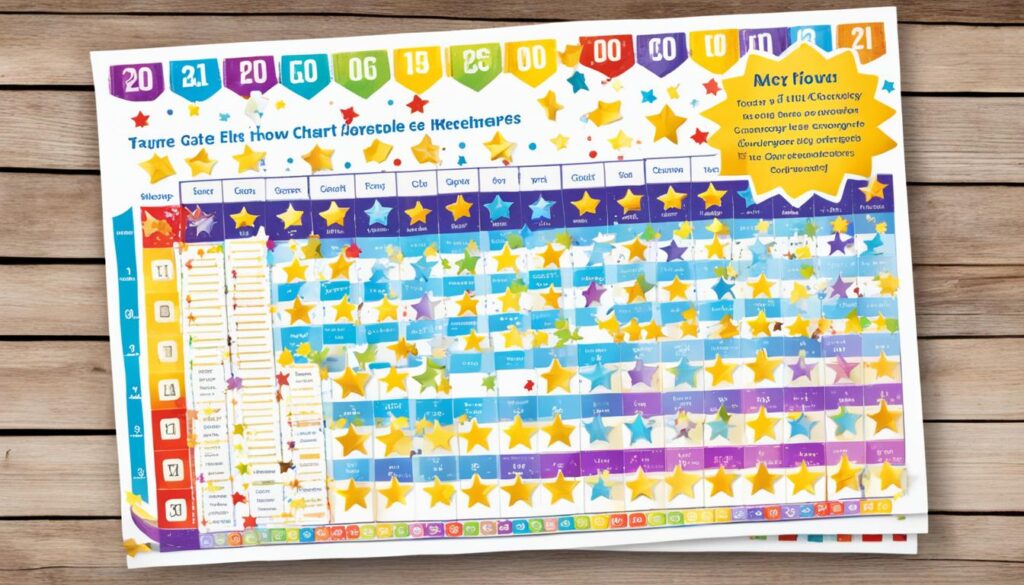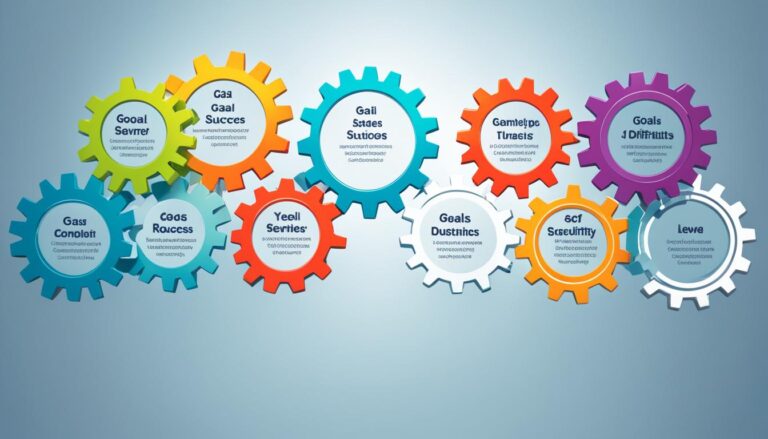Achieve Success with Types of Goal Setting Techniques

“The greater danger for most of us lies not in setting our aim too high and falling short, but in setting our aim too low and achieving our mark.” – Michelangelo
Goal setting is a powerful tool that can propel individuals and organizations towards success. Setting effective goals provides clarity, direction, and motivation to accomplish our aspirations. By exploring different types of goal setting techniques, you can develop a roadmap to achieve your objectives and surpass your own expectations.
Key Takeaways:
- Writing down your goals helps solidify your intentions and improve visualization.
- Creating SMART goals ensures they are specific, measurable, achievable, realistic, and time-bound.
- Breaking down goals into mini-goals makes them more manageable and leads to incremental progress.
- Using incentives, such as a rewards system, can motivate and enhance performance.
- Building accountability through tracking progress and seeking feedback increases the chances of success.
Write Goals Down
One effective goal-setting technique is to physically write your goals down. This simple action can have a powerful impact on your ability to achieve your objectives. When you write your goals down, you are taking them out of the realm of abstract thoughts and turning them into concrete statements.
Writing goals down provides several benefits. Firstly, it helps you keep track of your goals. By having your goals written in front of you, you can easily refer to them and ensure that you are staying focused on what you want to achieve. It also solidifies your intentions and serves as a reminder of what you are working towards.
Another important aspect of writing goals down is that it helps prevent excuses. When your goals are only in your mind, it’s easier to come up with reasons why you can’t or shouldn’t pursue them. But when you put them on paper, you are making a commitment to yourself and increasing your accountability.
Furthermore, writing goals down allows you to visualize and define your goals. By putting your goals into words, you bring them to life and give them shape and substance. This visualization process helps clarify what you truly want to achieve and increases your motivation.
When writing your goals, it’s important to focus on the positive aspects. Instead of framing your goals in negative terms such as “stop doing X,” try to express them in positive language that emphasizes the direction you want to go. For example, instead of writing “Quit unhealthy habits,” you can write “Adopt a healthy lifestyle.”
By writing your goals down and visualizing them, you are taking a proactive step towards achieving them. It helps you stay motivated and grateful for the progress you make. So grab a pen and paper, and start writing down your goals today!

Create SMART Goals
Once you have identified your goals and written them down, it’s time to make them SMART. SMART goals are specific, measurable, achievable, realistic, and time-bound. This framework ensures that your goals are well-defined and increase your chances of success.
- Specific: Be clear and precise about what you want to achieve. Set specific objectives that leave no room for ambiguity.
- Measurable: Set criteria to track your progress and determine when you have achieved your goal. By having measurable goals, you can assess your performance along the way.
- Achievable: Make sure your goals are within reach and align with your skills, resources, and capabilities. Setting achievable goals will keep you motivated and focused on your progress.
- Realistic: Ensure that your goals are realistic and attainable in the given context. Consider your current circumstances, constraints, and available resources.
- Time-bound: Set a deadline for your goals to create a sense of urgency. Having a time frame helps you stay focused, prioritize effectively, and ensures you make progress consistently.
Practicing SMART goal-setting allows you to set specific, measurable, achievable, realistic, and time-bound objectives. Let’s take a look at an example of how a SMART goal can be constructed:
| Goal: | Create a comprehensive marketing campaign for a new product launch. |
|---|---|
| SMART Goal: | Develop a detailed marketing plan, including target audience analysis, messaging strategy, and media channels selection, within the next 4 weeks. |
By following the SMART goal-setting technique, you can ensure that your objectives are well-defined, trackable, attainable, and aligned with your resources and time frame.
Create Mini-Goals
When it comes to achieving your goals, breaking them down into mini-goals is a powerful strategy. These smaller, more manageable objectives allow you to focus on specific steps and make incremental progress towards your larger aspirations. By setting mini-goals, you can track your advancement and experience success along the way.
Creating mini-goals helps you overcome the overwhelm that can arise from tackling big goals all at once. Instead, you break down your main goal into bite-sized tasks that are easier to accomplish. This approach not only makes your goals more achievable, but it also boosts your motivation and confidence as you tick off each mini-goal.
Think of mini-goals as stepping stones towards your ultimate destination. Each mini-goal represents a small victory, and as you accomplish them one by one, you’ll gain momentum and move closer to your desired outcome. Celebrate these mini-successes to stay motivated and encouraged on your journey.
Benefits of Mini-Goals:
1. Breaking down goals: Mini-goals help you break down complex objectives into simpler, actionable tasks.
2. Incremental progress: By focusing on mini-goals, you make steady progress towards your larger goals.
3. Trackable milestones: Each mini-goal achieved is a milestone that you can celebrate and track your progress.
4. Habit formation: Mini-goals can become habits and contribute to long-term success.
Use the power of mini-goals to turn your big dreams into manageable action steps. Start by identifying the mini-goals that will lead you to your ultimate goal, and create a plan to tackle them one by one. Stay focused, stay motivated, and celebrate your incremental victories along the way.

Examples of Mini-Goals in Different Areas of Life
| Area of Life | Ultimate Goal | Mini-Goal |
|---|---|---|
| Career | Become a Manager | Complete a Leadership Course |
| Health | Run a Marathon | Run 5k without stopping |
| Personal Development | Write a Book | Write 500 words every day |
| Finance | Save for a Down Payment | Save $500 per month |
Use Incentives
When it comes to motivating and energizing your employees, using incentives can be a game-changer. Incentives create a sense of excitement and provide a desirable reason to achieve goals within a specific timeframe. By implementing a rewards system that aligns with your employees’ preferences, you can boost collaboration, enhance productivity, and create a positive work environment.
Imagine a workplace where employees are inspired to go above and beyond, driven by the prospect of tangible rewards for their hard work. This type of incentive program not only encourages goal achievement but also fosters a sense of camaraderie and healthy competition among team members.
Benefits of Using Incentives
The advantages of using incentives in your goal-setting process are manifold:
- Increased motivation: Incentives provide an extra push for individuals to strive for success and put in their best effort.
- Enhanced teamwork: A rewards system can bring employees together, encouraging collaboration and cooperation.
- Improved productivity: With the prospect of rewards, employees are more likely to work efficiently and meet deadlines.
- Positive work environment: Incentives create a culture of appreciation and recognition, leading to higher employee satisfaction.
By leveraging the power of incentives, you create a win-win situation for both your employees and your organization. Employees are motivated to achieve their goals, while your business benefits from increased productivity and overall success.
Aligning Incentives with Employee Preferences
Implementing an effective incentive program requires understanding what motivates your employees. While monetary rewards can be appealing to many, others may find non-monetary incentives more valuable. It’s important to take into account individual preferences and tailor the incentives to match.
You can start by conducting surveys or holding team discussions to gather insights and determine what type of rewards would be most meaningful to your employees. Recognizing exceptional performance, offering flexible work hours, or providing professional development opportunities are just a few examples of non-monetary incentives that can make a significant impact.
Case Study: Recognize and Reward Excellence
One company that effectively utilizes incentives to motivate its employees is XYZ Corporation. The organization has implemented a comprehensive rewards system that recognizes and rewards employees for their exceptional performance. The program offers a variety of incentives, including bonuses, time off, and opportunities for career advancement.
| Benefits of XYZ Corporation’s Incentive Program | Employee Testimonials |
|---|---|
| Financial rewards for outstanding achievements | “Being recognized for my hard work has been incredibly motivating. The financial rewards have helped me achieve my personal goals and maintain high levels of productivity.” |
| Career advancement opportunities | “The opportunity to grow within the company has given me a clear path for my professional development. It’s motivated me to work hard and aim for excellence.” |
| Flexible work hours | “Having the flexibility to balance my work and personal life has had a positive impact on my well-being. It’s allowed me to stay motivated and perform at my best.” |

XYZ Corporation’s success story highlights the transformative power of using incentives to drive employee motivation and improve overall performance. By recognizing and rewarding excellence, they have created a work environment that fosters growth, collaboration, and a strong sense of purpose.
Remember, when implementing incentives, it’s essential to regularly evaluate their effectiveness and make adjustments as needed. By staying attuned to your employees’ preferences and continuously improving your incentive program, you can ensure long-term success and keep your team motivated to achieve their goals.
Build In Accountability
Building accountability is crucial for goal setting success. By incorporating accountability measures into your goal-setting process, you ensure that you stay motivated and on track to achieve your objectives. Accountability involves regularly evaluating your progress, tracking milestones, and receiving feedback.
One effective way to hold yourself accountable is by setting up personal tracking systems. This can include using goal-tracking apps, creating progress charts or journals, or even partnering with an accountability buddy. By consistently monitoring your progress, you can identify areas where you may need to make adjustments and celebrate your achievements along the way.
Another approach to accountability is involving others who can hold you accountable. This could be a mentor, a coach, or a trusted colleague. Sharing your goals and progress with someone else adds an extra layer of responsibility and support. Feedback from these individuals can provide valuable insights, encouragement, and suggestions for improvement.
Remember, accountability is not just about meeting expectations; it’s about continuous growth and improvement. Embrace the process, learn from setbacks, and stay committed to your goals. By incorporating accountability into your goal-setting strategy, you increase your chances of success and unlock your full potential.

Benefits of Accountability:
- Keeps you focused and motivated
- Provides regular feedback and guidance
- Helps track your progress and celebrate milestones
- Encourages personal growth and improvement
Accountability Methods:
| Methods | Description |
|---|---|
| Personal Tracking Systems | Use goal-tracking apps, charts, or journals to monitor your progress. |
| Accountability Partners | Partner with someone who can support and hold you accountable. |
| Mentors or Coaches | Seek guidance and feedback from experienced individuals. |
Continuously Evaluate Progress
Ensuring the success of your goal-setting process requires a continuous evaluation of your progress. By regularly assessing your goals, identifying any obstacles or challenges, and making necessary adjustments, you can stay on track and make improvements along the way. This evaluation process allows you to maintain motivation and ensure that your goals remain relevant and aligned with your vision.
Progress evaluation is the key to unlocking your full potential and achieving the desired outcomes. It allows you to gauge your progress, identify areas for improvement, and make goal adjustments accordingly. By staying committed to evaluating your progress, you can make the necessary tweaks to your strategy, ensuring that you stay on the path to success.
The Importance of Goal Adjustments
Through regular progress evaluation, you gain valuable insights into your goal attainment journey. This evaluation process empowers you to recognize when adjustments are needed to your goals. Whether it’s modifying timelines, reallocating resources, or redefining objectives, making goal adjustments allows you to adapt to changing circumstances and enhance your chances of success.
Goal adjustments demonstrate your flexibility and willingness to adapt your strategies when needed. It enables you to overcome unexpected challenges and seize new opportunities, keeping you ahead of the curve. By proactively making necessary adjustments, you ensure that your goals remain achievable and aligned with your evolving priorities.
Staying on Track
One of the key benefits of continuous progress evaluation is that it helps you stay on track. By regularly assessing your progress, you maintain a clear understanding of your goals and the steps required to achieve them. This ensures that you stay focused and motivated, even when faced with obstacles or distractions.
Staying on track requires discipline and commitment. It involves consistently reviewing your progress, identifying any deviations, and taking proactive measures to realign yourself with your goals. By remaining vigilant and dedicated to your goal-setting process, you increase your chances of success and minimize the risk of veering off course.
A Strategy for Staying on Track
To stay on track with your goals, consider implementing the following strategies:
- Regular Check-Ins: Schedule regular check-ins where you reassess your progress, evaluate your actions, and determine if any adjustments are required.
- Tracking Tools: Utilize goal tracking tools and software to monitor your progress, track milestones, and stay organized.
- Accountability Partners: Engage a trusted individual who can provide support and hold you accountable for your progress.
- Goal Reminders: Create visual reminders of your goals, such as vision boards or daily affirmations, to keep them at the forefront of your mind.
| Benefits of Staying on Track | Strategies for Staying on Track |
|---|---|
| 1. Maintains focus and motivation | 1. Regular check-ins |
| 2. Increases productivity and efficiency | 2. Tracking tools |
| 3. Enhances decision-making | 3. Accountability partners |
| 4. Facilitates timely goal attainment | 4. Goal reminders |
Conclusion
Goal setting is a powerful tool for achieving success. By exploring different types of goal setting techniques, such as writing goals down, creating SMART goals, setting mini-goals, using incentives, building accountability, and continuously evaluating progress, you can create a roadmap for your success.
By writing your goals down, you solidify your intentions and visualize your path to success. Creating SMART goals ensures clarity, measurability, achievability, realism, and timely completion of your objectives. Setting mini-goals helps break down larger goals into manageable steps, fostering incremental progress and long-term success.
Using incentives and building accountability keep you motivated and on track toward achieving your goals. Rewarding yourself or your team for reaching milestones can boost collaboration and create a positive work environment. Regularly evaluating progress allows you to make necessary adjustments, stay focused, and maintain your motivation.
Start implementing these goal setting techniques today, and unlock your potential for achieving more. With a clear vision and roadmap in place, you are well on your way to accomplishing your dreams and reaching new levels of success.






